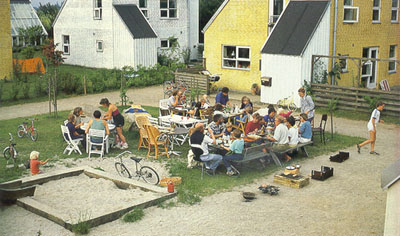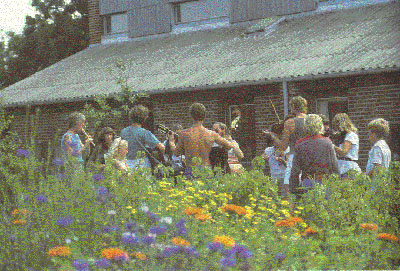of using Ecological Infrastructure?
The most profound implication, perhaps, is that ecological infrastructure
requires participation. Most of our present mechanical systems are
dealt with by flipping a switch, turning a faucet knob, or flushing a
toilet and then paying a utility bill at the end of the month. We
have little interaction with these systems, little understanding of how
they really work, and little control over them. By contrast, infrastructure
such as water collection, waste treatment, and food production which are
modelled on ecological processes are best dealt with at the individual
building or neighbourhood scale. Since these systems are located
close to the people who depend on them, these people will interact with
them to an extent which most of us are presently unaccustomed to in our
society. This will require a few changes. First of all, people
who use these systems will have to understand how they work and what is
necessary for them to be properly maintained. This will mean some
basic individual and community education (link to Education
for an Eco-Neighbourhood). The systems themselves will also
become teachers. As people begin to actively interact with these
support systems, people will learn about basic ecological processes such
as the hydrologic cycle, nutrient cycling, and energy flows. This
learning will enable people to become better stewards of the places they
live and more capable advocates for environmental protection in general.
Second, for those systems that operate at a neighbourhood scale, some
sort of organizational network will need to be in place that allows for
the appropriate sharing of a common resource. Such a scenario implies
the opportunity for social connections to evolve around activities like
neighbourhood gardening. Active participation in ecological infrastructure
also means that people are given more direct control over their lives
and are less subject to the whims of others. This also begins to
suggest a spiritual dimension to the participatory elements mentioned
above. With traditional mechanical infrastructure, the average user
is insignificant to the system; whether they are there or not makes no
difference. With ecological infrastructure, however, there is a
symbiotic relationship between the systems and the users; the user is
necessary and therefor has an important role play in a vital living system;
the user has a place in the world. Feeling like we have a place
in the world may be reason enough to bring ecology more fully into our
lives; all the other benefits are simply icing on the cake!


Pictures from Cohousing: A Contemporary Approach to Housing Ourselves by Kathryn McCamant and Charles Durrett
• Michael Reynolds, Earthships: Volume 1, (Solar Survival Press; Taos, New Mexico, 1990).
• Nancy Jack Todd & John Todd, From Eco-Cities to Living Machines: Principles of Ecological Design, (North Atlantic Books; Berkeley, 1994).
• Sim Van der Ryn & Stuart Cowan, Ecological Design, (Island Press; Washington, DC, 1996).
• David Pearson, The Natural House Book: Creating a Healthy, Harmonious, and Ecologically Sound Home Environment, (Simon and Schuster; New York, 1989).
• David Pearson, Earth to Spirit: In Search of Natural Architecture, (Gaia Books Limited; London, 1994).
• Sydney & Joan Baggs, The Healthy House: Creating a Safe, Healthy, and Environmentally Friendly Home, (Harper Collins Publishers; Sydney, 1996).
• Farallones Institute staff et.al, The Integral Urban House: Self Reliant Living in the City (Sierra Club Books; San Francisco, 1979).
Links
• Ecological Design links
http://www.ecodesign.org/edi/
http://www.ecodesign.bc.ca/
http://www.west.net/~prince/
http://home.earthlink.net/~jluke313/
NextPage